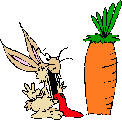
Choosing Your Rabbit
Who Lives With Who?
Housing
Feeding
Handling
Breeding
Pregnancy
The New Litter
Surrogacy
Hand-Rearing
Health
Vets Bills
Pictures
 Feeding
Feeding
As
herbivores, a rabbit needs a diet consisting almost entirely of vegetable
matter. Your rabbit will NOT eat meat so don’t even bother trying it. The diet
will contain a full range of proteins, fats, and carbohydrates, together with
vitamins and minerals, but the proteins and fats will be those of vegetable
origin, such as are found in wheat. This
diet can be enriched by milk, and by providing a mineral lick.
A
good mash is a mixture of flaked maize, crushed oats, mixed corn, rabbit
pellets, and bran, made into a crumbly mash with hot water or milk, or fed dry.
Cooked potato peelings, or potatoes, can be added.
An
alternative is wholemeal bread, made into a mash with hot or cold milk, and
possibly with an added measure of bran. White
bread should not be fed, and rabbits that dislike a mash, and prefer dry food,
should have their wholemeal bread toasted or baked hard in the oven.
A
substantial meal like this should normally be fed once a day, or more when
necessary, for instance for pregnant or nursing does.
In
addition to their mash, rabbits will need another meal each day consisting of
greenstuffs, vegetables, and fruits. Suitable
fresh foods include apples, Brussels sprouts, cabbage, carrots, cauliflower,
celery, chicory, kale, parsnip, pears, peas and their pods, spinach, swede, and turnip.
Rabbits
will eat many of the wild plants collected from the countryside, such as
agrimony, coltsfoot, comfrey, cow parsnip, goosegrass, hedge parsley, knapweed,
shepherd's purse, and sow thistle. They
will also graze grass and its associated weeds including plantain, chickweed,
dandelion and clover.
Even
if the rabbits cannot safely be let out into the garden to feed, they can be
allowed some controlled grazing by the use of a portable ark.
This is constructed of wire-mesh on a timber frame of triangular shape,
with a roof at one end to give shelter from bad weather.
In
the wild all the herbivores spend a great deal of time feeding, and captive
rabbits similarly need the activity it provides.
This is the reason highly concentrated foods such as pellets, although
nutritionally balanced, are best fed with plenty of fresh foods, and with hay.
Hay of the best quality is a staple food for rabbits, and should be
available at all times.
It is very important for
good teeth wear (to stop over grown teeth) and healthy digestion. For hygienic reasons
it is best given in a hay rack, rather than put on the hutch floor, where it
will become trampled and soiled. A
rack of hay each day will allow rabbits to feed sporadically throughout their
waking hours, as in nature.
Good
hygiene needs to be considered. Besides
using a rack for hay, caring owners find it most satisfactory to put mash in
heavy, earthenware pots that are easy to wash, and to use a drip-feed bottle for
drinking water.
Do
not overfeed your pet. Twice a day (morning and night) is sufficient. However,
if you have a pregnant doe you should ensure that she has food available at all
times, both during and after the pregnancy.
Foods
to avoid include the following:
Lettuce
– it is a common myth that rabbits need lettuce. Yes they will eat it but it
is harmful to their digestive system so should be avoided.
Poisonous
Plants – foxglove, yew, creeping buttercup and all plants from bulbs.
Rabbits
need a constant supply of cold fresh water. This should be supplied in a
drinking bottle that is attached to the outside of the cage through the wire
mesh. These bottles are readily available at any pet store. Water provided in
pots will quickly get spilled and soiled so is not advisable. The water should
be changed daily and more often in hot weather as it will quickly get warm.
Don’t forget in the winter that the water may freeze so you will need to
‘defrost’ the bottle (sometimes more than once a day).